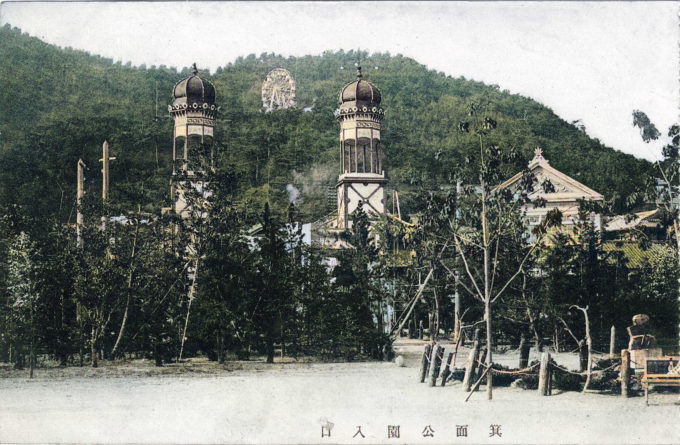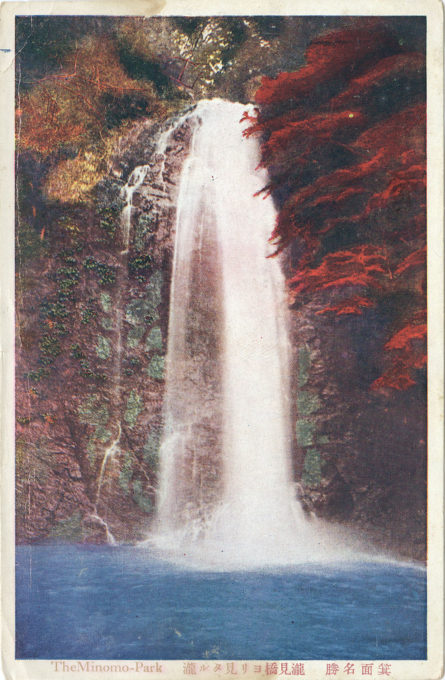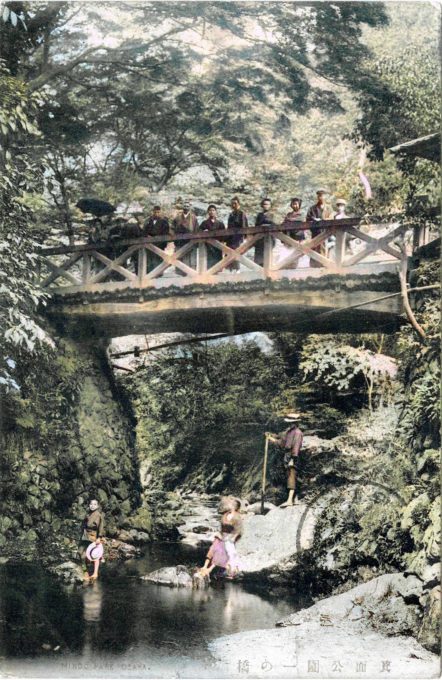
Mino-o [Minoh] Park Entrance, Osaka, c. 1915. Mino-o Onsen and the Minoh Kanko Hotel were established in 1907 and 1910 respectively when the Minoo Line (the predecessor of today’s Hankyu Line) was opened at the same time as the main line heading for Takarazuka. Minoo Park represented one of the first attempts at tourist and leisure time tourism by entrepreneur Kobayashi Ichizō who could go on to found the Takarazuka Revue in 1914. It was around this time that Kobayashi removed some of the amusement park elements of Minoo Park for use at his newly completed Takarazuka amusement centers. Today, Minoo Park enjoys a status as a quasi-National Park known for its spectacular spring and fall foliage and Minoo Falls, so-named because of its similarity in appearance to a farmer’s grain winnowing basket [mi, 箕]. (Colorized)
See also:
Minoo (Minoh) Waterfall, Osaka, ca. 1930.
Takarazuka Hotel, Takarazuka Baths & the Takarazuka Grand Theatre, Takarazuka, c. 1920-1930.
Rakutenchi amusement park, Sennichimae Osaka, c. 1920.
“After an hour’s electric-car ride through the quiet main thoroughfare, they return to Umeda-machi, and thence they again take a suburban trolley car bound for Mino-o, a hilly spot known as a park, the northern suburbs.
“… The Mino-o park is a production more of nature than of man; for its beauty and charms are mainly in its wild, uncultured jungles, its dense thickets of cedars, pines, maples and cherries, its natural springs and its mountain streams that flow the deep gullys and narrow gutters.
“The Minomo Park”, Mihoh Falls, Osaka, c. 1920. “[W]ith a water-fall in it over 22 feet in height and a mountain torrent flowing in the park for 360 yards … [t]he park abounds in maple trees and artistically shaped rocks. The scenery is really the best in Japan.” – Mino-o-Arima Electric Railway Co. advertisement, The Japan Magazine, November 1911.
“The hill apparently forms a link of what may be virtually called a small mountain chain; and there is practically no boundary in this vast natural park. An attempt had been evidently made to introduce some element of artificiality in order to justify the name of a park; but so far as the things are actually going on there at the time of the Editor’s visit, the attempt can hardly be said anything but a very poor one. It only indicates a strange conception of the people of Osaka who somehow seem anxious that the place should be known by a brightening term, ‘park,’ instead of simple unassuming Mino-o, a mountainous place under which appellation the spot would go better and be advertised more broadly.
“The real Mino-o, then, is a mountain resort, fit to spend a week or two in summer on account of its cool tree shades, worthy of a visit in autumn because of its maples and wild scenes , appropriate to be there in winter since its weather is mild and dry, and suitable for going there in spring inasmuch as it has pleasing verdure and delightful blossoms.
“Two hours are spent in Mino-o, and the Pilgrim and his friend return to the city.”
– “Osaka and Its Sights”, by The Editor, The Musashino, February 1913



